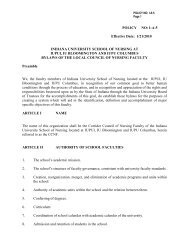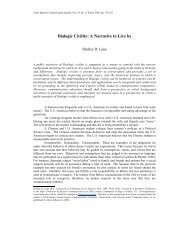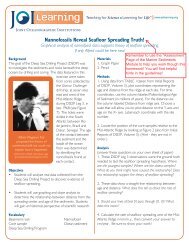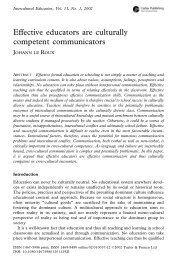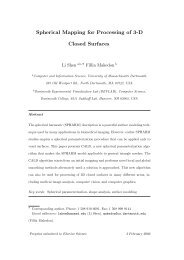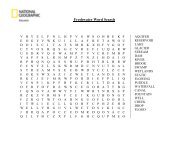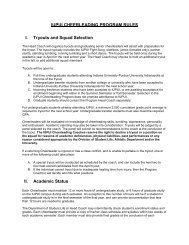Cryptorchidism and Testicular Cancer: Separating Fact From ... - IUPUI
Cryptorchidism and Testicular Cancer: Separating Fact From ... - IUPUI
Cryptorchidism and Testicular Cancer: Separating Fact From ... - IUPUI
You also want an ePaper? Increase the reach of your titles
YUMPU automatically turns print PDFs into web optimized ePapers that Google loves.
Review Articles<br />
<strong>Cryptorchidism</strong> <strong>and</strong> <strong>Testicular</strong> <strong>Cancer</strong>:<br />
<strong>Separating</strong> <strong>Fact</strong> <strong>From</strong> Fiction<br />
Hadley M. Wood <strong>and</strong> Jack S. Elder*<br />
<strong>From</strong> the Glickman Urological <strong>and</strong> Kidney Institute, Clevel<strong>and</strong> Clinic, Clevel<strong>and</strong>, Ohio, <strong>and</strong> Vattikuti Urology Institute, Henry Ford Hospital <strong>and</strong><br />
Children’s Hospital of Michigan, Detroit (JSE), Michigan<br />
Abbreviations<br />
<strong>and</strong> Acronyms<br />
ASA American Society of<br />
Anesthesiologists<br />
ITGCN intratubular germ cell<br />
neoplasia<br />
UDT undescended testis<br />
Submitted for publication July 5, 2008.<br />
* Correspondence: Vattikuti Urology Institute,<br />
Henry Ford Hospital, 2799 West Gr<strong>and</strong> Blvd., K-9,<br />
Detroit, Michigan 48202 (telephone: 313-916-<br />
2626; FAX: 313-916-2956; e-mail: jelder1@hfhs.<br />
org).<br />
Purpose: We dissected prevailing assumptions about cryptorchidism <strong>and</strong> reviewed<br />
data that support <strong>and</strong> reject these assumptions.<br />
Materials <strong>and</strong> Methods: Five questions about cryptorchidism <strong>and</strong> the risk of<br />
testicular cancer were identified because of their implications in parent counseling<br />
<strong>and</strong> clinical management. St<strong>and</strong>ard search techniques through MEDLINE®<br />
were used to identify all relevant English language studies of the questions being<br />
examined. Each of the 5 questions was then examined in light of the existing<br />
data.<br />
Results: The RR of testicular cancer in a cryptorchidism case is 2.75 to 8. A RR<br />
of between 2 <strong>and</strong> 3 has been noted in patients who undergo orchiopexy by ages 10<br />
to 12 years. Patients who undergo orchiopexy after age 12 years or no orchiopexy<br />
are 2 to 6 times as likely to have testicular cancer as those who undergo<br />
prepubertal orchiopexy. A contralateral, normally descended testis in a patient<br />
with cryptorchidism carries no increased risk of testis cancer. Persistently cryptorchid<br />
(inguinal <strong>and</strong> abdominal) testes are at higher risk for seminoma (74%),<br />
while corrected cryptorchid or scrotal testicles that undergo malignant transformation<br />
are most likely to become nonseminomatous (63%, p 0.0001), presumably<br />
because of a decreased risk of seminoma.<br />
Conclusions: Orchiectomy may be considered in healthy patients with cryptorchidism<br />
who are between ages 12 <strong>and</strong> 50 years. Observation should be recommended<br />
in postpubertal males at significant anesthetic risk <strong>and</strong> all males older<br />
than 50 years. While 5% to 15% of scrotal testicular remnants contain germinal<br />
tissue, only 1 case of carcinoma in situ has been reported, suggesting that the risk<br />
of malignancy in these remnants is extremely low.<br />
Key Words: testis, testicular neoplasms, cryptorchidism, abnormalities, risk<br />
CRYPTORCHIDISM, also known as UDT,<br />
is the most common congenital abnormality<br />
of the genitourinary tract. Being<br />
so, it has earned a good deal of<br />
interest by urologists in general <strong>and</strong><br />
pediatric urologists in particular. Curiously<br />
however, cryptorchidism, its<br />
causes <strong>and</strong> its potential associated<br />
testicular cancer risk have historically<br />
been poorly understood <strong>and</strong> documented,<br />
resulting in a number of<br />
misconceptions that have been passed<br />
down through generations of urologists.<br />
A major problem with characterizing<br />
risk between cryptorchidism<br />
<strong>and</strong> testis cancer relates to diagnosing<br />
<strong>and</strong> documenting cryptorchidism.<br />
Retrospective analyses, which represent<br />
most data upon which conclusions<br />
can be drawn, may include men<br />
with retractile testes, men with a history<br />
of spontaneous descent during<br />
infancy or at puberty, men who un-<br />
452 www.jurology.com<br />
0022-5347/09/1812-0452/0 Vol. 181, 452-461, February 2009<br />
THE JOURNAL OF UROLOGY ®<br />
Printed in U.S.A.<br />
Copyright © 2009 by AMERICAN UROLOGICAL ASSOCIATION<br />
DOI:10.1016/j.juro.2008.10.074
CRYPTORCHIDISM AND TESTICULAR CANCER 453<br />
derwent treatment with hormonal stimulation <strong>and</strong><br />
men with persistent UDT after previous orchiopexy.<br />
While estimates of the incidence of cryptorchidism<br />
based on pediatrician examination <strong>and</strong> birth records<br />
are 1% to 2% at age 12 months, various groups have<br />
suggested that the rate of surgery for cryptorchidism<br />
is approximately double the estimated risk (3%<br />
to 4%), suggesting that the risk of UDT may vary<br />
during childhood depending on linear growth <strong>and</strong><br />
timing of puberty, retractile testes, ascending testes<br />
<strong>and</strong> missed diagnosis among other things. 1–4<br />
Part of the confusion as it relates to cryptorchidism<br />
<strong>and</strong> testis cancer may also be because the rates<br />
of UDT <strong>and</strong> testis cancer are heterogeneous <strong>and</strong><br />
changing. 5 Even in different populations of northern<br />
Europe the incidence of testis cancer is widely discrepant,<br />
ranging from 0.9/100,000 person-years in<br />
Lithuania to 7.8/100,000 person-years in 1980 in<br />
Denmark. 6 Some groups have postulated an effect of<br />
changing environmental conditions, such as an altered<br />
hormonal milieu in utero related to increased<br />
exposure to synthetic estrogens <strong>and</strong> estrogen-like<br />
chemicals. 7 The observation that formerly cryptorchid<br />
testes demonstrate a higher rate of carcinoma<br />
in situ <strong>and</strong> malignant transformation suggests an<br />
association. However, whether the condition of maldescent<br />
predisposes to dysplasia or is a marker of<br />
aberrant gonadocyte development in fetal life remains<br />
unanswered. Data supporting the former is<br />
that with unilateral maldescent the UDT is more<br />
likely to demonstrate malignant transformation.<br />
Evidence supporting the latter is that with unilateral<br />
maldescent the normally descended testis has<br />
historically been believed to be at increased risk for<br />
tumor. 8 We analyzed some of the prevailing assumptions<br />
about cryptorchidism <strong>and</strong> reviewed data that<br />
support <strong>and</strong> reject these assumptions.<br />
METHODS<br />
Five questions relating to cryptorchidism <strong>and</strong> associated<br />
testicular cancer risk were identified. 1) What is the RR of<br />
testicular cancer in a cryptorchid or formerly cryptorchid<br />
testis? 2) In patients with unilateral cryptorchidism what<br />
is the RR of testicular cancer in a contralateral, normally<br />
descended testis? 3) Does testis location affect the subsequent<br />
pathological subtype of testicular cancer? 4) Does<br />
orchiopexy decrease the risk of testicular cancer? 5) Is<br />
there a risk of malignant degeneration for testicular remnants?<br />
These 5 questions were identified because of their<br />
clinical implications in the treatment of a child with UDT,<br />
<strong>and</strong> because of the divergence of opinions on these topics.<br />
St<strong>and</strong>ard electronic search methods were used (MED-<br />
LINE database). No limits were set on publication date<br />
<strong>and</strong> MEDLINE contains published literature dating back<br />
to 1950. References from review articles were also analyzed<br />
to identify studies that were not identified by MED-<br />
LINE searches <strong>and</strong> those that predate 1950. All searches<br />
were performed using st<strong>and</strong>ard search techniques with<br />
foreign language, nonhuman studies, editorials/letters, review<br />
articles <strong>and</strong> case reports excluded. While review articles<br />
were obtained <strong>and</strong> reviewed for references <strong>and</strong> content,<br />
this discussion only includes relevant English<br />
language case series, cohort studies, case-control studies<br />
<strong>and</strong> meta-analyses.<br />
In addition, chapters from urological textbooks were<br />
reviewed for content <strong>and</strong> references. When deemed relevant,<br />
the material was obtained for further review <strong>and</strong><br />
inclusion. Extensive literature reviews or meta-analyses<br />
have been published on 2 questions that we sought to<br />
answer 9–11 <strong>and</strong> these studies are cited. No additional attempts<br />
were made to perform meta-analyses of the remaining<br />
3 questions largely due to a lack of prospective<br />
data on these topics as well as to wide variability in the<br />
nature of the studies done of these subjects.<br />
RESULTS AND DISCUSSION<br />
Questions 1 to 3 demonstrated significant overlap in<br />
the relevant literature <strong>and</strong>, therefore, they were<br />
queried together. An initial search using the keywords<br />
testis cancer, risk factor, cryptorchidism <strong>and</strong><br />
undescended testis revealed more than 900 articles,<br />
of which 43 provided relevant information. An additional<br />
8 studies were identified upon reviewing the<br />
bibliographies of the relevant studies. Additional<br />
reviews for orchiopexy, age <strong>and</strong> testis (190 articles,<br />
of which 23 were relevant), <strong>and</strong> orchiectomy, age<br />
<strong>and</strong> cryptorchidism (111, of which 10 were relevant)<br />
as well as multiple searches using testicular, remnant,<br />
nubbin, testis <strong>and</strong> cancer (14 relevant studies)<br />
were done to investigate questions 4 <strong>and</strong> 5. While<br />
not all studies reviewed could be presented in this<br />
analysis, table 1 lists those selected for discussion,<br />
categorized by study type.<br />
Question 1) What is the RR of <strong>Testicular</strong> <strong>Cancer</strong><br />
in a Cryptorchid or Formerly Cryptorchid Testis?<br />
An association between testicular maldescent <strong>and</strong><br />
testis cancer has been known for more than a century.<br />
12 Few urologists would argue with the statement<br />
that there is an association between UDT <strong>and</strong><br />
testicular cancer. However, a review of major urological<br />
textbooks suggests that the risk is poorly<br />
quantified. Campbell-Walsh Urology, 9th edition<br />
states, “It is a well established fact that children<br />
born with undescended testes are at increased risk<br />
for malignancy. . . the RR is approximately 40 times<br />
greater.” 13 However, in Adult <strong>and</strong> Pediatric Urology<br />
it is stated that “The combined risk for all cryptorchid<br />
males, irrespective of the location of the testes,<br />
has been calculated at 20 to 46 times greater than<br />
for patients with normally located testes.” 14 In Pediatric<br />
Urology it is stated that “Individuals born<br />
with an undescended testis have approximately a<br />
40-fold incidence of testicular malignancy over those<br />
born with scrotal testes.” 15
454<br />
CRYPTORCHIDISM AND TESTICULAR CANCER<br />
Table 1. Categorization of select articles based on question of interest <strong>and</strong> study design<br />
Study Type<br />
References<br />
Questions 1–3:<br />
Retrospective cohort/pathology review Johnson et al, 8 Gilbert <strong>and</strong> Hamilton, 16 Campbell, 17 Kanto et al, 18 Prener et al, 19 Cortes et al, 22 Swerdlow et al, 23<br />
Pinczowski et al, 26 Pettersson et al, 28 Strader et al, 30 Ford et al, 32 Gehring et al, 33 Fonger et al, 34 Batata et al, 35<br />
Jones et al, 58 Kuo et al 59<br />
Meta-analysis Martin, 9 Dieckmann <strong>and</strong> Pichlmeier 10<br />
Case-control Coupl<strong>and</strong> et al, 24 Moller et al, 25 Pottern et al, 27 Herrinton et al, 29 United Kingdom <strong>Testicular</strong> <strong>Cancer</strong> Study Group, 31<br />
Sabroe <strong>and</strong> Olsen 37<br />
Question 4:<br />
Retrospective cohort/pathology review Kogan et al, 14 Pinczowski et al, 26 Pettersson et al, 28 Rogers et al, 39 Hornak et al, 40 Rusnak et al 46<br />
Meta-analysis Martin, 9 Walsh et al 11<br />
Case-control Pottern et al, 27 Herrinton et al, 29 Sabroe <strong>and</strong> Olsen 37<br />
Prospective, nonr<strong>and</strong>omized Berkowitz et al 2<br />
Other Farrer et al, 41 Oh et al 42<br />
Question 5:<br />
Retrospective cohort/pathology review Grady et al, 47 Plotzker et al, 50 Turek et al, 51 Renzulli et al, 54 Emir et al, 52 Storm et al, 53 De Luna et al, 55<br />
Cendron et al, 56 Rozanski et al 57<br />
The source of these estimates dates back to 2<br />
seminal studies of this topic, each published in the<br />
1940s. The first series by Gilbert <strong>and</strong> Hamilton used<br />
5 data sets published between 1828 <strong>and</strong> 1927 to<br />
generate an estimate of the incidence of UDT in<br />
men. 16 A total of almost 10 million military recruits<br />
from the British, French, American, Austrian <strong>and</strong><br />
Scottish armies were included in these 5 studies,<br />
which together suggested a 0.23% incidence of UDT.<br />
The methods used to diagnose, document <strong>and</strong> report<br />
these cases are not discussed in the study, so that it<br />
is not possible to determine whether the diagnosis of<br />
UDT was based on physical examination <strong>and</strong>/or history.<br />
Gilbert <strong>and</strong> Hamilton reported that approximately<br />
11% of their patients (840 of about 7,000)<br />
with testicular cancer had associated “testicular ectopy.”<br />
16 They then compared the “background incidence”<br />
of UDT, as estimated using military recruit<br />
data, with the incidence of UDT in their testicular<br />
cancer population, generating a 48-fold (0.11/0.0023)<br />
excess risk of cancer in patients with UDT. The<br />
other study by Campbell used the same combined<br />
army recruit data <strong>and</strong>, therefore, obtained the same<br />
estimate of UDT in the general population<br />
(0.23%). 17 Campbell observed a 11.6% rate of UDT<br />
in his cohort of patients with testicular cancer, 17<br />
which was similar to the rate observed by Gilbert<br />
<strong>and</strong> Hamilton. 16 Although it is still widely quoted,<br />
the RRs generated by these 2 studies have proved to<br />
be substantial overestimates.<br />
The 0.23% overall incidence of cryptorchidism<br />
used in the 2 historical studies 16,17 likely significantly<br />
underestimated the true incidence since modern<br />
series a demonstrate rate of UDT of between<br />
1.1% <strong>and</strong> 1.6% at age 1 year. 1–2,10 Modern analysis<br />
suggests that the rate of prior cryptorchidism in<br />
men with testicular cancer is around 5% to 10%. 18,19<br />
An accurate estimate of the lifetime risk of testicular<br />
cancer in a man who otherwise has no risk factors<br />
has often been quoted to be 1 in 500. 20 However, this<br />
estimate was generated 30 years ago based on data<br />
from a New York State Registry. 21 Table 2 lists<br />
relevant studies that reflect a wide variety of populations.<br />
A review of these studies showed some variability<br />
in risk estimates, ranging between 2.75 <strong>and</strong><br />
8. 18,19,22–28 The disparity of RR may be accounted for<br />
by several factors. 1) Some of these studies included<br />
patients who were treated with hormonal <strong>and</strong> surgical<br />
therapy, 23 others only included patients<br />
treated with surgical therapy 26 <strong>and</strong> yet others did<br />
not specify whether patients underwent prior therapy<br />
for UDT. 2) These studies reflect many populations,<br />
<strong>and</strong> the incidence of testicular cancer <strong>and</strong><br />
cryptorchidism is known to be widely heterogeneous.<br />
6 3) These studies reflect a number of different<br />
design types.<br />
Dieckmann et al performed a meta-analysis that<br />
included 20 of the modern published series, including<br />
those by Prener, 19 Swerdlow, 23 Coupl<strong>and</strong>, 24<br />
Moller, 25 Herrinton, 29 <strong>and</strong> Strader 30 et al, <strong>and</strong> determined<br />
a 4.0 to 5.7 RR of testis cancer <strong>and</strong> cryptorchidism.<br />
10 Given the congruity among studies performed<br />
on this topic across the globe, there exists<br />
strong evidence that the risk of testis cancer in cryptorchid<br />
<strong>and</strong> formerly cryptorchid testes is most probably<br />
an order of magnitude less than that initially<br />
estimated by Campbell, 17 <strong>and</strong> Gilbert <strong>and</strong> Hamilton. 16<br />
While early reports may have overstated the RR<br />
of testicular cancer <strong>and</strong> UDT, they correctly identified<br />
settings that significantly increase risk, including<br />
bilateral UDT, which often coexists with abnormalities<br />
of the external genitalia, endocrinopathy<br />
<strong>and</strong>/or an abnormal karyotype, <strong>and</strong> abdominally retained<br />
testes compared with inguinal or scrotal testes.<br />
These 2 observations have endured as our underst<strong>and</strong>ing<br />
of cryptorchidism <strong>and</strong> testicular cancer<br />
has been refined in the last 70 years. 22,31 Rates of<br />
testicular neoplasia <strong>and</strong> ITGCN appear to be higher
CRYPTORCHIDISM AND TESTICULAR CANCER 455<br />
Table 2. Testis cancer in UDT <strong>and</strong> contralateral normally descended testis, <strong>and</strong> association between orchiopexy <strong>and</strong><br />
testis cancer risk<br />
References<br />
Country<br />
Study<br />
Calculated Risk<br />
Period Type No. Pts UDT Contralar Testis<br />
Age at Orchiopexy-Risk<br />
Association<br />
Pottern et al 27 United States 1976–1981 Retrospective 530 RR 3.7 RR 1.1 Age at correction-risk<br />
case control<br />
Strader et al 30 Washington State 1974–1988 Case-control 1,436 RR 8.0 RR 1.6 (95% CI Not provided<br />
0.6–4.1)<br />
Pinczowski et al 26 Sweden 1965–1983 Prospective 2,918 RR 7.4 Not provided Age at correction-risk<br />
database<br />
Moller et al 25 Denmark 1986–1988* Prospective<br />
case-control<br />
803 RR 3.6† 1.3‡ Weak age at correction-risk<br />
(p 0.07)<br />
Prener et al 19 Denmark 1941–1957 Retrospective 549 Adjusted RR 3.6§<br />
Age at correction-risk<br />
case-control<br />
RR 5.2<br />
Swerdlow et al 23 United Kingdom 1951–1964 Prospective 1,124 RR 7.5 RR 2.1‡ None<br />
database<br />
Coupl<strong>and</strong> et al 24 United Kingdom 1984–1986 Retrospective<br />
case-control<br />
794 OR 3.82 Not provided Not provided, trend toward<br />
more seminoma in late<br />
(after age 15 yrs) or<br />
uncorrected UDT<br />
Kanto et al 18 Japan 1975–2002 Retrospective<br />
database<br />
240 RR 5.4 RR 1 Age at orchiopexy not<br />
discussed<br />
Cortes et al 22 Denmark 1971–2004 Prospective 1,466 RR 4 Not provided Not provided<br />
database<br />
Pettersson et al 28 Sweden 1965–2000 Prospective<br />
database<br />
16,983 IR 2.75 Not provided Age at correction-risk<br />
* Cases, not controls.<br />
† After excluding spontaneously descended UDT.<br />
‡ Only 1 affected patient (CI not provided).<br />
§ Five affected patients (CI not provided).<br />
in cases of retained intra-abdominal testes. In 1<br />
series 7 of 60 UDTs (12%) that were biopsied in<br />
adults demonstrated ITGCN, of which 4 of 16 (25%)<br />
were intra-abdominal <strong>and</strong> 3 of 44 (7%) were inguinal.<br />
32 This suggests a higher risk associated with<br />
malignant degeneration in abdominally retained<br />
testes compared to that in inguinally retained testes. 32<br />
Question 2) In Patients<br />
With Unilateral <strong>Cryptorchidism</strong><br />
What is the RR of <strong>Testicular</strong> <strong>Cancer</strong><br />
in a Contralateral, Normally Descended Testis?<br />
Multiple publications emphasize that in a man with<br />
a history of UDT the contralateral, normally descended<br />
testis also is at increased risk for malignant<br />
degeneration. Campbell-Walsh Urology states, “Between<br />
5% <strong>and</strong> 10% of patients with a history of<br />
cryptorchidism develop malignancy in the contralateral,<br />
normally descended gonad.” 20 Pediatric Urology<br />
similarly states that “In about 10% of individuals<br />
with unilateral cryptorchidism <strong>and</strong> cancer, the<br />
tumor develops in the contralateral testis, suggesting<br />
a possible genetic predisposition.” 14 Finally, Pediatric<br />
Urology states, “The observation that 10 to<br />
20% of testicular tumors in patient with cryptorchidisms<br />
occurs in the normally descended testis suggests<br />
that an intrinsic abnormality is present in<br />
both testes even when only one is undescended.” 15<br />
While the evidence for an approximately 5-fold risk<br />
of testis cancer in formerly cryptorchid gonads exists,<br />
data supporting an increased risk in a contralateral,<br />
normally descended testis are weaker.<br />
Some investigators have attempted to characterize<br />
the RR of cancer in a contralateral, normally descended<br />
testis (table 2). 18,19,23,25,27,30 Four such studies<br />
indicated an excess risk in these gonads. 19,23,25,30<br />
Three series indicated a RR of between 1 <strong>and</strong> 2. 23,25,30<br />
However, in 2 series the number of individuals affected<br />
was low (1% or less of the study population) <strong>and</strong><br />
the CI was not provided, 23,25 suggesting that these<br />
findings may have reflected the background risk (table<br />
2). Strader et al reported an increased risk to the<br />
contralateral descended testis (RR 1.6) in patients<br />
with a history of testicular cancer in Washington<br />
State. 30 However, these data were based on patient<br />
recall <strong>and</strong> were not validated by patient examination<br />
or record, while the lower limit of the reported CI for<br />
the estimate was less than 1. In another study Prener<br />
et al reported an RR of 3.6 for a normally descended<br />
contralateral testis based on a case-control study from<br />
the Danish <strong>Cancer</strong> Registry. 19 This group reported<br />
that 5 of 155 testicular cancer cases (3%) were observed<br />
in normally descended testes opposite a UDT.<br />
This series st<strong>and</strong>s alone in demonstrating a meaningful<br />
increased risk associated with normally descended
456<br />
CRYPTORCHIDISM AND TESTICULAR CANCER<br />
testes. Other studies have failed to show an increased<br />
risk to the contralateral testis. 18,27<br />
Of 147 cases of testis cancer at Wilford Hall Medical<br />
Center the neoplasm was in the contralateral,<br />
normally descended testis in only 3 (2%). 8 Gehring<br />
et al presented a series of 529 patients with testicular<br />
cancer, of whom 7 (1.3%) had tumor in the<br />
normally descended testicle. 33 Fonger et al reported<br />
testis cancer in normally descended contralateral<br />
testes in 6 of 646 patients with testis cancer. 34 Finally,<br />
Batata et al reported a series of 125 testicular<br />
cancers in patients with cryptorchidism from among<br />
“approximately 1,000” with testicular cancer. 35 Ten<br />
of these cases developed in a contralateral, normally<br />
descended testis, suggesting that the rate of tumors<br />
in contralateral, normally descended testes is about<br />
1% (10 of 1,000), while the risk of testis cancer in<br />
formerly or currently cryptorchid testes is about 10-<br />
fold higher (115 of 1,000). Combining these case<br />
series shows that 26 of 2,322 men (1.1%) in whom<br />
testicular cancer developed had tumor in the normally<br />
descended testis opposite a cryptorchid or formerly<br />
cryptorchid testis.<br />
Mathematically an increased risk of testicular<br />
cancer in a normal contralateral testis seems unlikely.<br />
If 10% of men with testicular cancer have<br />
tumor in a UDT <strong>and</strong> only 1.1% of testis tumors<br />
develop in the normally descended contralateral testis,<br />
the risk of a tumor in the UDT is 8.33 times<br />
higher than the risk in the contralateral testis. However,<br />
results from the study by Dieckmann <strong>and</strong><br />
Pichlmeier indicate that the risk of testicular cancer<br />
in the UDT is 5.4 times that in the normal population,<br />
10 suggesting that the risk of a tumor in the<br />
contralateral testis is similar to that in the normal<br />
male population.<br />
Viewed another way, while the incidence of UDT<br />
in the general population of children is estimated to<br />
be between 1% <strong>and</strong> 4%, 1–4,36 only approximately 1%<br />
to 2% of testis tumors develop in normally descended<br />
testes contralateral to a UDT. This suggests<br />
that a tumor in these otherwise normal testes is<br />
most probably circumstantial <strong>and</strong> not indicative of<br />
an increased predisposition toward malignancy in a<br />
man with a unilateral undescended testis.<br />
Question 3) Does Testis<br />
Location Affect the Subsequent<br />
Pathological Subtype of <strong>Testicular</strong> <strong>Cancer</strong>?<br />
The first thorough analysis of this question was<br />
provided in an historical review of 220 cases of testicular<br />
cancer that occurred following orchiopexy in<br />
43 case series dated from 1950 to the mid 1970s. 9<br />
Therefore, this study represents a time when orchiopexy<br />
was generally not performed before puberty.<br />
Overall 40% of cases demonstrated seminoma, followed<br />
by embryonal tumors <strong>and</strong> teratocarcinoma in<br />
25% <strong>and</strong> 19%, respectively. 9 A chart review of Air<br />
Force patients entered into a testicular cancer registry<br />
between 1954 <strong>and</strong> 1967 included men who underwent<br />
postpubertal orchiopexy at a mean age of 16<br />
years <strong>and</strong> also had similar types of tumors, although<br />
with a lower rate of seminoma (27%) 8 than in the<br />
study by Martin. 9 Gehring et al reported a similar<br />
pattern with a 46%, 21% <strong>and</strong> 32% rate of seminoma,<br />
embryonal tumors <strong>and</strong> teratocarcinoma, respectively,<br />
in testicles that underwent malignant degeneration<br />
following orchiopexy. 33 These values compare<br />
with an 89% predominance of seminoma in<br />
patients who had uncorrected cryptorchidism <strong>and</strong><br />
later had testicular cancer. 33<br />
Subsequently Batata et al reported a series of<br />
men with testicular cancer <strong>and</strong> a history of cryptorchidism.<br />
35 They compared men who underwent orchiopexy<br />
between ages 4 <strong>and</strong> 42 years to patients<br />
who had not undergone orchiopexy <strong>and</strong> noted a similar<br />
time to tumor detection <strong>and</strong> a similar survival<br />
rate in the 2 groups. However, when comparing<br />
pathological types between cases with <strong>and</strong> without<br />
orchiopexy or hormonal treatment, a predominance<br />
of seminoma was observed in uncorrected cases (30<br />
of 42 or 71.4%). However, in corrected cases the<br />
distribution of tumor type was remarkably similar<br />
to that in the series by Johnson et al, 8 including<br />
seminoma in 29% of cases, embryonal tumors in 33%<br />
<strong>and</strong> teratocarcinoma in 35%. The reason for this<br />
discrepancy may be that a predominance of abdominal<br />
testes was represented by the uncorrected<br />
group, which is a group more likely to undergo negative<br />
inguinal exploration as well as failed hormone<br />
therapy. Indeed, one of the most compelling findings<br />
in this study is that 13 of 14 abdominal testes later<br />
demonstrated seminoma compared with 63% with<br />
seminoma in the inguinal region <strong>and</strong> only 30% with<br />
seminoma in scrotal testes. 35<br />
While treatment patterns for orchiopexy have<br />
trended toward earlier surgical correction, more<br />
contemporary series have confirmed the findings<br />
suggested by these 3 early studies. Approximately<br />
a third of corrected UDTs that undergo malignant<br />
transformation are seminomatous, while almost<br />
three-quarters of uncorrected UDTs that undergo<br />
malignant degeneration are seminomatous<br />
(p 0.0001, table 3).<br />
Unfortunately the initial location of scrotal testicular<br />
tumors in corrected cases was not documented<br />
in all studies that included patients who had undergone<br />
orchiopexy. Consequently while these data<br />
suggest that a cryptorchid abdominal testis left in<br />
situ is more likely to become seminomatous, it does<br />
not answer the question of whether orchiopexy simply<br />
results in a trade-off of the risk of seminoma for<br />
nonseminoma or decreases the risk of seminoma<br />
altogether, resulting in a lower but still increased
CRYPTORCHIDISM AND TESTICULAR CANCER 457<br />
Table 3. Seminoma <strong>and</strong> nonseminoma in patients with history of cryptorchidism based on testis location at cancer diagnosis<br />
(chi-square 42.35, p 0.0001)<br />
No. Scrotal Testes<br />
No. UDTs<br />
References<br />
Seminoma Nonseminoma Seminoma Nonseminoma<br />
Johnson et al 8 3 8 1 0<br />
Gehring et al 33 13 15 8 1<br />
Martin 9 34 50<br />
Fonger et al 34 13 9 25 6<br />
Batata et al 35 26 67 30 14<br />
Jones et al 58 2 7 16 9<br />
Kuo et al 59 9 2<br />
Totals (%) 91 (37) 156 (63) 89 (74) 32 (26)<br />
risk of testicular cancer. While these 2 possibilities<br />
exist, data suggest that the latter is more likely, that<br />
is orchiopexy does in fact decrease the overall risk of<br />
testicular cancer.<br />
Question 4) Does Orchiopexy<br />
Decrease the Risk of <strong>Testicular</strong> <strong>Cancer</strong>?<br />
The prevalence of UDT in hospital based prospective<br />
cohorts has been estimated to be between 3% <strong>and</strong> 4%<br />
at birth, 1,2 although the prevalence is higher in low<br />
birth weight, pre-term <strong>and</strong> small for gestational age<br />
males. 1 Importantly while more than two-thirds of<br />
these cases demonstrate descent by age 3 months,<br />
the rate of UDT is estimated to be near 1% after age<br />
12 months. 2,4,36 This value is important since improved<br />
medical expertise <strong>and</strong> technology in perinatal<br />
care have led to a greater number of pre-term<br />
infants surviving the neonatal period <strong>and</strong>, although<br />
many of these infants have UDT, spontaneous descent<br />
often occurs before age 1 year. These values<br />
suggest that at least half of all testes that are undescended<br />
at birth will descend on their own <strong>and</strong><br />
little is known about the potential oncological risk to<br />
this group of patients. A Danish group compared<br />
rates of testicular cancer in controls <strong>and</strong> patients<br />
diagnosed with cryptorchid testes at birth who were<br />
born from 1950 to 1968 <strong>and</strong> found no increased<br />
risk. 37 It is quite possible that the failure of this<br />
study to identify an association between UDT at<br />
birth <strong>and</strong> testicular cancer may have been related to<br />
the high prevalence of UDT in neonates <strong>and</strong> the high<br />
rate of early spontaneous descent, which diluted the<br />
number of true or persistently cryptorchid testicles.<br />
All other studies presented that suggest a link between<br />
UDT <strong>and</strong> testicular cancer are retrospective.<br />
As such, they rely on a history of hormonal or surgical<br />
therapy, or a diagnosis of maldescent found in<br />
adult life <strong>and</strong>, therefore, they exclude or under represent<br />
patients who may have undergone spontaneous<br />
descent in infancy. Moreover, because these<br />
studies predominantly involve patients born in the<br />
1930s to 1960s, they likely do not reflect the relatively<br />
larger number of pre-term infants who now<br />
survive to adulthood, a group that commonly demonstrates<br />
UDT at birth with spontaneous descent in<br />
infancy. Therefore, these data suggest that orchiopexy<br />
<strong>and</strong> forewarnings to parents of an increased<br />
cancer risk should be restrained before ages 3 to 12<br />
months, especially in infants born pre-term.<br />
Moreover, several investigators have suggested<br />
that the rate of cryptorchidism or at least surgery<br />
for cryptorchidism may increase after age 1 year<br />
secondary to a testis migrating to an ectopic location<br />
with linear growth, retractile testes, missed diagnoses<br />
or acquired undescended testes, while the oncological<br />
risk for these testes <strong>and</strong> any potential benefit<br />
that may be gained with early treatment remain<br />
to be determined. 3–4,36,38<br />
The evidence that orchiopexy before puberty is<br />
protective is strong <strong>and</strong> 2 studies published in 2007<br />
point toward a decreased risk of malignancy in testes<br />
that are subjected to orchiopexy before ages 10 to<br />
12 years. 11,28 The first study from Sweden included<br />
almost 17,000 men treated for UDT between 1965<br />
<strong>and</strong> 2000, <strong>and</strong> identified 56 who were subsequently<br />
diagnosed with testicular cancer. 28 The RR of testicular<br />
cancer was then estimated based on age at<br />
orchiopexy, including 0 to 6, 7 to 9, 10 to 12, 13 to 15<br />
<strong>and</strong> 16 to 19 years. While the 3 younger groups had<br />
an RR of between 2.02 <strong>and</strong> 2.35, the 2 postpubertal<br />
groups were at significantly increased risk with an<br />
RR of 5.06 <strong>and</strong> 6.24, respectively. The second series<br />
is a meta-analysis that included 3 case-control 25,29,30<br />
<strong>and</strong> 2 cohort 23,26 studies that used age at orchiopexy<br />
in the analysis. 11 This analysis determined an OR of<br />
5.8 (range 1.6 to 19.3) for testicular cancer in men<br />
who never underwent orchiopexy or underwent postpubertal<br />
orchiopexy compared with that in men in<br />
whom orchiopexy was performed before puberty. 11<br />
The suspicion that prepubertal orchiopexy may be<br />
protective dates back to the review by Martin, in<br />
which only 6 of 72 patients underwent orchiopexy<br />
before age 10 years. 9 However, even when consider-
458<br />
CRYPTORCHIDISM AND TESTICULAR CANCER<br />
ing the risk in children who undergo orchiopexy at<br />
ages less than 10 years, the lowest incidence of cancer<br />
is seen in children undergoing orchiopexy in the<br />
0 to 6-year age range. 28 Other studies have shown a<br />
greatly increased risk for cancer in testicles left in<br />
situ that have not been brought down or have been<br />
brought down later than age 10 years. Herrinton et<br />
al evaluated orchiopexy timing <strong>and</strong> testis cancer<br />
risk in a modern cohort of patients from California.<br />
29 Of men with testis cancer 7% had a history of<br />
treated or untreated ectopic testes compared to a<br />
1.4% rate in healthy controls. In the 12 patients with<br />
testicular cancer the earliest documented orchiopexy<br />
was done after age 5 years, while in the control<br />
group 6 of 8 patients had undergone orchiopexy by<br />
age 11 years. An OR of 0.6 was calculated for testicular<br />
cancer in patients treated before age 11 years<br />
<strong>and</strong> an OR of 32 was noted in those treated later.<br />
Likewise Pinczowski et al presented a population<br />
based cohort study of 2,900 men who underwent<br />
orchiopexy <strong>and</strong> 30,000 who underwent hernia repair<br />
between 1965 <strong>and</strong> 1983. 26 In the orchiopexy group 4<br />
patients had testicular cancer, including 1 <strong>and</strong> 3<br />
who underwent orchiopexy at age 10 to 14 years <strong>and</strong><br />
greater than 15 years, respectively. No testicular<br />
cancers were noted in patients who underwent orchiopexy<br />
at ages less than 11 years.<br />
In a patient older than 12 years the decision to<br />
observe, remove or fix a UDT is complex. The risk of<br />
malignancy is increased. Moreover, these gonads are<br />
likely to be atrophic <strong>and</strong> have negligible fertility<br />
value. 39 Hornak et al reported that 12% of UDTs<br />
removed from a cohort of men with a mean age of 28<br />
years demonstrated atypia <strong>and</strong> 1 (3%) demonstrated<br />
ITGCN. 40 However, a decision to operate (orchiopexy<br />
or orchiectomy) involves anesthetic risk. This<br />
risk has been evaluated by multiple groups.<br />
In 1985 Farrer et al compared the risk of malignant<br />
degeneration <strong>and</strong> subsequent death from testicular<br />
cancer to the risk of anesthetic or postoperative<br />
mortality after orchiopexy. 41 They concluded<br />
that men with UDT who are between ages 15 <strong>and</strong> 32<br />
years should undergo orchiectomy because the risk<br />
of death due to cancer outweighed the surgical risks<br />
associated with orchiectomy, whereas men older<br />
than 32 years should be treated nonoperatively.<br />
While this group used the most contemporary data<br />
available to estimate the anesthetic risk, testicular<br />
cancer mortality <strong>and</strong> the RR of malignant transformation<br />
in a retained testis, these risks have significantly<br />
changed because of improved anesthetic<br />
drugs <strong>and</strong> techniques, improved operative management<br />
<strong>and</strong> improved testicular cancer survival rates.<br />
A study published in 2002 revisited this question by<br />
stratifying anesthetic risk by ASA class <strong>and</strong> using<br />
more modern mortality estimates for testicular cancer.<br />
42 According to that risk analysis all ASA class I<br />
patients with UDT are recommended to undergo<br />
orchiectomy <strong>and</strong> all ASA class III <strong>and</strong> IV patients<br />
are recommended to undergo observation. The risk<br />
of death due to anesthesia exceeds the risk due to<br />
testicular cancer in ASA class II adults with UDT at<br />
age 43 years. Therefore, the investigators recommended<br />
that orchiectomy be performed up to age 50<br />
years in postpubertal ASA class I <strong>and</strong> II men with<br />
UDT, while nonoperative treatment should be done<br />
in all postpubertal ASA class III <strong>and</strong> IV men, <strong>and</strong> all<br />
men older than 50 years.<br />
A confounding issue is whether the testis is palpable.<br />
If the testis is inguinal or ectopic, a testicular<br />
neoplasm should be palpable before it becomes large<br />
<strong>and</strong> it certainly would be visible on sonography. On<br />
the other h<strong>and</strong>, a neoplasm in an abdominal or peeping<br />
testis would be impossible to palpate or image by<br />
sonography at an early stage. Consequently since<br />
abdominal testes are at highest risk for neoplasia<br />
<strong>and</strong> screening is difficult, reasonably healthy adults<br />
with unilateral nonpalpable testes should undergo<br />
definitive evaluation by laparoscopy or possibly gadolinium<br />
enhanced magnetic resonance angiography.<br />
43,44 Orchiectomy should be advised unless medical<br />
circumstances preclude anesthesia.<br />
Briefly, these data suggest that pre-term infants<br />
with testicular maldescent should be allowed at<br />
least 3 to 12 months to provide a window during<br />
which spontaneous descent may occur. If a testis has<br />
not descended before age 12 months (corrected for<br />
pre-term birth), consideration should be given to<br />
perform orchiopexy before age 10 to 11 years to<br />
decrease the cancer risk. A number of studies suggest<br />
that even earlier orchiopexy (younger than age<br />
2 years) is beneficial to maximize fertility potential<br />
but a critical analysis of this literature is not within<br />
the scope of our discussion. In patients with bilateral<br />
maldescent parents should strongly be advised<br />
toward orchiopexy even before age 12 months because<br />
these patients are at higher risk for testicular<br />
malignancy <strong>and</strong> infertility in adulthood. 45,46 Finally,<br />
reasonably healthy postpubertal men younger than<br />
50 years who seek consultation for a nonpalpable<br />
UDT should be offered orchiectomy <strong>and</strong> a testicular<br />
prosthesis since the fertility potential of that testis<br />
is likely to be negligible <strong>and</strong> the cancer risk is likely<br />
substantial (at least 1%). Men with a palpable UDT<br />
who are older than 50 years or at significant operative<br />
risk should be treated nonoperatively because<br />
the risk of operative mortality exceeds the risk of<br />
death due to testis cancer <strong>and</strong> germ cell tumors are<br />
uncommon at ages greater than 50 years.<br />
Patients with a unilateral solitary UDT or bilateral<br />
UDTs who are seen after ages 10 to 12 years can<br />
be appropriate c<strong>and</strong>idates for orchiopexy with close<br />
surveillance. <strong>Testicular</strong> biopsy may be useful for
CRYPTORCHIDISM AND TESTICULAR CANCER 459<br />
Table 4. Intratesticular tissue pathological findings reported in testicular remnants in retrospective reviews of the literature<br />
References<br />
Location<br />
Study<br />
Period<br />
No. Nubbins<br />
Evaluated Ring Status Age<br />
Intratesticular Tissue Pathological Findings<br />
(No. pts)<br />
Rozanski et al 57<br />
Ann Arbor,<br />
Michigan<br />
1984–1994 50 Inguinal <br />
scrotal<br />
Grady et al 47 Seattle,<br />
Washington<br />
1993–1997 14 Inguinal <br />
scrotal<br />
Cendron et al 56 West Lebanon, 1983–1997 29 Inguinal <br />
New<br />
scrotal<br />
Hampshire<br />
Emir et al 52 Istanbul, Turkey 1922–2004 39 Inguinal <br />
scrotal<br />
Storm et al 53<br />
Renzulli et al 54<br />
De Luna et al 55<br />
Plotzker et al 50<br />
Turek et al 51<br />
Danville,<br />
Pennsylvania<br />
Norfolk,<br />
Virginia<br />
New Haven,<br />
Connecticut <br />
Providence,<br />
Rhode Isl<strong>and</strong><br />
New Orleans,<br />
Louisiana<br />
Washington,<br />
D.C.<br />
Philadelphia,<br />
Pennsylvania<br />
Not reported<br />
1–17 Yrs (81% of<br />
pts younger than<br />
4 yrs)<br />
Viable germ cells (5), intratubular germ cell<br />
neoplasia (1 age 9 yrs)<br />
Closed Mean 23 mos No germinal tissue (13), several<br />
seminiferous tubules (1 age 13 mos)<br />
Not reported Mean 28.6 mos No testicular elements (29)<br />
(range 3–168)<br />
Closed<br />
Mean 4.1 yrs<br />
(range 1–13)<br />
1994–2006 56* — Median 44.5 mos<br />
(range 11–216)<br />
1981–2003 110 Inguinal <br />
scrotal<br />
1990–2000 71 Inguinal <br />
scrotal<br />
1987–1989 23 Inguinal <br />
scrotal<br />
1985–1991 105 Inguinal <br />
scrotal<br />
Closed<br />
Not reported<br />
Median 33 mos<br />
(range 6 mos–<br />
14 yrs)<br />
9 Mos–10 yrs (no<br />
mean or median<br />
reported)<br />
No testicular elements (34), seminiferous<br />
tubules only (3), seminiferous tubules <br />
viable germ cells (2)<br />
Viable germ cell elements (8), seminiferous<br />
tubules without germ cell elements (4)<br />
Viable germ cell elements (8), No.<br />
specimens with vas but no germ cell<br />
elements not reported<br />
Residual viable tubules without germ cells<br />
(7),† residual viable tubules with germ<br />
cells (4)<br />
Not reported Not reported Viable seminiferous tubules (3)<br />
Not reported<br />
Mean 26.8 mos<br />
(range 5 mos–<br />
14 yrs)<br />
Testis (7), müllerian (2)<br />
When possible, only inguinal nubbins are reported that were found after laparoscopy confirmed vessels <strong>and</strong> vas going into closed ring.<br />
* Remnants were retrieved laparoscopically, suggesting that they were intra-abdominal, or removed retrograde through an open inguinal ring.<br />
† Associated hernia (open ring) in 5 of 7 patients.<br />
deciding the course of action in this select subgroup<br />
of patients.<br />
Question 5) Is There a Risk of Malignant<br />
Degeneration in <strong>Testicular</strong> Remnants?<br />
Approximately 50% of nonpalpable testes are abdominal/inguinal<br />
<strong>and</strong> the remaining 50% are atrophic<br />
nubbins or remnant testes resulting from perinatal<br />
spermatic cord torsion. 47,48 These structures<br />
are almost always in the scrotum. 49 They are often<br />
found after laparoscopy reveals testicular vessels<br />
<strong>and</strong> a vas deferens entering a closed inguinal<br />
ring 47,48 <strong>and</strong> subsequent exploration demonstrates a<br />
small, hemosiderin containing nubbin. The question<br />
arises of whether these testes carry an increased<br />
risk of testicular cancer <strong>and</strong>, therefore, they should<br />
be removed. These testes are abnormal because of a<br />
mechanical event (spermatic cord torsion), rather<br />
than maldevelopment. Therefore, the increased risk<br />
of malignancy associated with an undescended testis<br />
should not be applied to testicular remnants associated<br />
with spermatic cord torsion.<br />
Multiple histological studies of these remnants<br />
have demonstrated that few contain seminiferous<br />
tubules (0% to 14%) <strong>and</strong> even fewer demonstrated<br />
viable germ cells (table 4). 47,50–56 Grady et al identified<br />
14 of 35 nonpalpable testes that were inguinal/<br />
scrotal vanishing testes. 47 Only 1 remnant contained<br />
seminiferous tubules <strong>and</strong> no germ cells were<br />
identified on histological evaluation. These findings<br />
are in agreement with the findings of Cendron et al,<br />
who did not identify any testicular elements in 29<br />
testicular nubbins. 56 None showed evidence of malignancy,<br />
which is not surprising since most of these<br />
boys were prepubertal. However, Rozanski et al performed<br />
histological analysis of 50 testicular remnants<br />
<strong>and</strong> reported that 5 (10%) contained germ<br />
cells. 57 However, more importantly 1 remnant in a<br />
9-year-old boy demonstrated intratubular germ cell<br />
neoplasia. Theoretically, testicular remnants without<br />
germ cells are not at risk for later malignant<br />
degeneration into a germ cell tumor even if the<br />
remnant gonad is inguinal. Consequently the likelihood<br />
of a scrotal testicular remnant becoming malignant<br />
is extremely low <strong>and</strong> it does not need to be<br />
removed if the clinician is certain that the testis is<br />
atrophic <strong>and</strong> in the scrotum. However, if there is any<br />
uncertainty regarding the diagnosis or exploration<br />
has been performed, removal of the nubbin through<br />
a scrotal incision <strong>and</strong> histological evaluation are<br />
quite appropriate.
460<br />
CRYPTORCHIDISM AND TESTICULAR CANCER<br />
CONCLUSIONS<br />
Despite countless studies of the risks associated<br />
with cryptorchidism <strong>and</strong> cancer many misconceptions<br />
still exist (see Appendix). It is important that<br />
we underst<strong>and</strong> the limitations <strong>and</strong> conclusions of<br />
the data that have been generated to date <strong>and</strong> design<br />
studies that more accurately <strong>and</strong> prospectively<br />
APPENDIX<br />
Conclusions<br />
define the risks better. In addition, it is important to<br />
establish guidelines for treating patients with cryptorchidism,<br />
including when orchiopexy is appropriate,<br />
when orchiectomy is appropriate, when testicular<br />
biopsy has a role, <strong>and</strong> how cryptorchid or<br />
formerly cryptorchid patients should be monitored<br />
for testis cancer.<br />
Question<br />
Summary<br />
1) What is the RR of testicular cancer in a cryptorchid testis? RR of testicular cancer in all patients with UDT is 2.75 to 8 with lower risk (RR 2 to 3) in<br />
patients undergoing prepubertal orchiopexy<br />
Higher risk in patients with bilateral UDT, associated genitourinary anomalies, or late (after age<br />
10-12 years) or uncorrected UDT<br />
2) In patients with unilateral cryptorchidism, what is the RR<br />
of testicular cancer in a contralateral normally descended<br />
testis?<br />
3) Does testis location affect the subsequent pathological<br />
subtype?<br />
The contralateral, normally descended testis has a negligible or no increased risk of testicular<br />
cancer<br />
Of malignant tumors developing in uncorrected abdominal or inguinal testes 74% are seminoma<br />
Of malignant testis tumors developing following orchiopexy 63% are nonseminomatous<br />
Orchiopexy appears to decrease the risk of seminoma<br />
4) Does orchiopexy decrease the risk of testicular cancer? Orchiopexy by age 10 to 12 years results in a2to6-fold RR decrease compared with orchiopexy<br />
after age 12 years or no orchiopexy<br />
Orchiectomy should be discussed with health postpubertal men with UDT up to age 50 years<br />
Risk of testis cancer in men with persistent UDT after age 50 years is undefined<br />
<strong>Testicular</strong> biopsy may serve a role in determining whether orchiopexy or orchiectomy should be<br />
performed in children 10 years or older with bilateral UDT <strong>and</strong> solitary unilateral UDT<br />
5) Is there a risk of malignant degeneration in a testicular<br />
There exists a single case of carcinoma in situ identified in a 9-year-old child<br />
remnant (nubbin)?<br />
Of testicular nubbins 5% to 15% contain seminiferous material but few have viable germ cells,<br />
the nubbin is almost always scrotal <strong>and</strong> the risk of malignant degeneration is minimal<br />
REFERENCES<br />
1. <strong>Cryptorchidism</strong>: a prospective study of 7500 consecutive<br />
male births, 1984 – 8: John Radcliffe<br />
Hospital <strong>Cryptorchidism</strong> Study Group. Arch Dis<br />
Child 1992; 67: 892.<br />
2. Berkowitz GS, Lapinski RH, Dolgin SE, Gazella<br />
JG, Bodian CA <strong>and</strong> Holzman IR: Prevalence <strong>and</strong><br />
natural history of cryptorchidism. Pediatrics 1993;<br />
92: 44.<br />
3. Chilvers C, Pike MC, Forman D, Fogelman K <strong>and</strong><br />
Wadsworth ME: Apparent doubling of frequency<br />
of undescended testis in Engl<strong>and</strong> <strong>and</strong> Wales in<br />
1962– 81. Lancet 1984; 2: 330.<br />
4. Cortes D, Kjellberg EM, Breddam M <strong>and</strong> Thorup<br />
J: The true incidence of cryptorchidism in Denmark.<br />
J Urol 2008; 179: 314.<br />
5. Bray F, Ferlay J, Devesa SS, McGlynn KA <strong>and</strong><br />
Moller H: Interpreting the international trends in<br />
testicular seminoma <strong>and</strong> nonseminoma incidence.<br />
Nat Clin Pract Urol 2006; 3: 532.<br />
6. Huyghe E, Natsyda T <strong>and</strong> Thonneau P: Increasing<br />
incidence of testicular cancer worldwide: a review.<br />
J Urol 2003; 170: 5.<br />
7. Norgil Damgaard I, Main KM, Toppari J <strong>and</strong><br />
Skakkebaek NE: Impact of exposure to endocrine<br />
disrupters in utero <strong>and</strong> in childhood on adult<br />
reproduction. Best Pract Res Clin Endocrinol<br />
Metab 2002; 16: 289.<br />
8. Johnson DE, Woodhead DM, Pohl DR <strong>and</strong> Robison<br />
JR: <strong>Cryptorchidism</strong> <strong>and</strong> testicular tumorigenesis.<br />
Surgery 1968; 63: 919.<br />
9. Martin DC: Germinal cell tumors of the testis<br />
after orchiopexy. J Urol 1979; 121: 422.<br />
10. Dieckmann KP <strong>and</strong> Pichlmeier U: Clinical epidemiology<br />
of testicular germ cell tumors. World<br />
J Urol 2004; 22: 2.<br />
11. Walsh TJ, Dall’Era MA, Croughan MS, Carroll PR<br />
<strong>and</strong> Turek PJ: Prepubertal orchiopexy for cryptorchidism<br />
may be associated with lower risk of<br />
testicular cancer. J Urol 2007; 178: 1440.<br />
12. Curling TB: Practical Treatise on the Diseases of<br />
the Testis <strong>and</strong> of the Spermatic Cord <strong>and</strong> Scrotum,<br />
2nd ed. Philadelphia: Blanchard <strong>and</strong> Lee<br />
1856.<br />
13. Schneck FX <strong>and</strong> Bellinger MF: Abnormalities of<br />
the testis <strong>and</strong> scrotum: surgical management. In:<br />
Campbell-Walsh Urology, 9th ed. Edited by AJ<br />
Wein, LR Kavoussi, AC Novick, AW Partin <strong>and</strong> CA<br />
Peters. Philadelphia: WB Saunders Co 2006;<br />
chapt 127.<br />
14. Kogan SJ, Hadziselimovic F, Howards SS, Snyder<br />
HJ III <strong>and</strong> Huff D: Pediatric <strong>and</strong>rology. In: Adult<br />
<strong>and</strong> Pediatric Urology. Edited by JY Gillenwater,<br />
JT Graystack, SS Howards <strong>and</strong> JW Duckett. Philadelphia:<br />
Lippincott Williams & Wilkins 2002; pp<br />
2572–2581.<br />
15. Baker LA, Silver RI <strong>and</strong> Docimo SG: <strong>Cryptorchidism</strong>.<br />
In: Pediatric Urology. Edited by JP Gearhart,<br />
RC Rink <strong>and</strong> PD Mouriquant. Philadelphia: WB<br />
Saunders Co 2001; chapt 46.<br />
16. Gilbert JB <strong>and</strong> Hamilton JB: Incidence <strong>and</strong> nature<br />
of tumors in ectopic testes. Surg Gynecol Obstet<br />
1940; 71: 731.<br />
17. Campbell HE: Incidence of malignant growth of<br />
the undescended testis. Arch Surg 1942; 44: 353.<br />
18. Kanto S, Hiramatsu M, Suzuki K, Ishidoya S, Saito<br />
H, Yamada S et al: Risk factors in past histories<br />
<strong>and</strong> familial episodes related to development of<br />
testicular germ cell tumor. Int J Urol 2004; 11:<br />
640.
CRYPTORCHIDISM AND TESTICULAR CANCER 461<br />
19. Prener A, Engholm G <strong>and</strong> Jensen OM: Genital<br />
anomalies <strong>and</strong> risk for testicular cancer in Danish<br />
men. Epidemiology 1996; 7: 14.<br />
20. Richie JP <strong>and</strong> Steele GS: Neoplasms of the testis.<br />
In: Campbell-Walsh Urology, 9th ed. Edited by AJ<br />
Wein, LR Kavoussi, AC Novick, AW Partin <strong>and</strong> CA<br />
Peters. Philadelphia: WB Saunders Co 2006;<br />
chapt 29.<br />
21. Zdeb MS: The probability of developing cancer.<br />
Am J Epidemiol 1977; 106: 6.<br />
22. Cortes D, Thorup J <strong>and</strong> Petersen BL: <strong>Testicular</strong><br />
neoplasia in undescended testes of cryptorchid<br />
boys— does surgical strategy have an impact on<br />
the risk of invasive testicular neoplasia? Turk<br />
J Pediatr, suppl., 2004; 46: 35.<br />
23. Swerdlow AJ, Higgins CD <strong>and</strong> Pike MC: Risk of<br />
testicular cancer in cohort of boys with cryptorchidism.<br />
BMJ 1997; 314: 1507.<br />
24. Coupl<strong>and</strong> CA, Chilvers CE, Davey G, Pike MC,<br />
Oliver RT <strong>and</strong> Forman D: Risk factors for testicular<br />
germ cell tumours by histological tumour type.<br />
United Kingdom <strong>Testicular</strong> <strong>Cancer</strong> Study Group.<br />
Br J <strong>Cancer</strong> 1999; 80: 1859.<br />
25. Moller H, Prener A <strong>and</strong> Skakkebaek NE: <strong>Testicular</strong><br />
cancer, cryptorchidism, inguinal hernia, testicular<br />
atrophy, <strong>and</strong> genital malformations: casecontrol<br />
studies in Denmark. <strong>Cancer</strong> Causes<br />
Control 1996; 7: 264.<br />
26. Pinczowski D, McLaughlin JK, Lackgren G, Adami<br />
HO <strong>and</strong> Persson I: Occurrence of testicular cancer<br />
in patients operated on for cryptorchidism <strong>and</strong><br />
inguinal hernia. J Urol 1991; 146: 1291.<br />
27. Pottern LM, Brown LM, Hoover RN, Javadpour N,<br />
O’Connell KJ, Stutzman RE et al: <strong>Testicular</strong> cancer<br />
risk among young men: role of cryptorchidism<br />
<strong>and</strong> inguinal hernia. J Natl <strong>Cancer</strong> Inst 1985; 74:<br />
377.<br />
28. Pettersson A, Richiardi L, Nordenskjold A, Kaijser<br />
M <strong>and</strong> Akre O: Age at surgery for undescended<br />
testis <strong>and</strong> risk of testicular cancer. N Engl J Med<br />
2007; 356: 1835.<br />
29. Herrinton LJ, Zhoa W <strong>and</strong> Husson G: Management<br />
of cryptorchidism <strong>and</strong> risk of testicular cancer.<br />
Am J Epidemiol 2003; 157: 602.<br />
30. Strader CH, Weiss NS, Daling JR, Karagas MR<br />
<strong>and</strong> McKnight B: <strong>Cryptorchidism</strong>, orchiopexy, <strong>and</strong><br />
the risk of testicular cancer. Am J Epidemiol<br />
1988; 127: 1013.<br />
31. Aetiology of testicular cancer: association with<br />
congenital abnormalities, age at puberty, infertility,<br />
<strong>and</strong> exercise. United Kingdom <strong>Testicular</strong> <strong>Cancer</strong><br />
Study Group. BMJ 1994; 308: 1393.<br />
32. Ford TF, Parkinson MC <strong>and</strong> Pryor JP: The undescended<br />
testis in adult life. Br J Urol 1985; 57:<br />
181.<br />
33. Gehring GG, Rodriguez FR <strong>and</strong> Woodhead DM:<br />
Malignant degeneration of cryptorchid testes following<br />
orchiopexy. J Urol 1974; 112: 354.<br />
34. Fonger JD, Filler RM, Rider WD <strong>and</strong> Thomas GM:<br />
<strong>Testicular</strong> tumours in maldescended testes. Can<br />
J Surg 1981; 24: 353.<br />
35. Batata MA, Whitmore WF Jr, Chu FC, Hilaris BS,<br />
Loh J, Grabstald H et al: <strong>Cryptorchidism</strong> <strong>and</strong><br />
testicular cancer. J Urol 1980; 124: 382.<br />
36. Campbell DM, Webb JA <strong>and</strong> Hargreave TB: <strong>Cryptorchidism</strong><br />
in Scotl<strong>and</strong>. BMJ 1987; 295: 1235.<br />
37. Sabroe S <strong>and</strong> Olsen J: Perinatal correlates of<br />
specific histological types of testicular cancer in<br />
patients below 35 years of age: a case-cohort<br />
study based on midwives’ records in Denmark. Int<br />
J <strong>Cancer</strong> 1998; 78: 140.<br />
38. Agarwal PK, Diaz M <strong>and</strong> Elder JS: Retractile<br />
testis—is it really a normal variant? J Urol 2006;<br />
175: 1496.<br />
39. Rogers E, Teahan S, Gallagher H, Butler MR,<br />
Grainger R, McDermott TE et al: The role of<br />
orchiectomy in the management of postpubertal<br />
cryptorchidism. J Urol 1998; 159: 851.<br />
40. Hornak M, Pauer M, Bardos A Jr <strong>and</strong> Ondrus D:<br />
The incidence of carcinoma in situ in the undescended<br />
testis. Int Urol Nephrol 1987; 19: 321.<br />
41. Farrer JH, Walker AH <strong>and</strong> Rajfer J: Management<br />
of the postpubertal cryptorchid testis: a statistical<br />
review. J Urol 1985; 134: 1071.<br />
42. Oh J, L<strong>and</strong>man J, Evers A, Yan Y <strong>and</strong> Kibel AS:<br />
Management of the postpubertal patient with<br />
cryptorchidism: an updated analysis. J Urol 2002;<br />
167: 1329.<br />
43. Yeung CK, Tam YH, Chan YL, Lee KH <strong>and</strong> Metreweli<br />
C: A new management algorithm for impalpable<br />
undescended testis with gadolinium enhanced<br />
magnetic resonance angiography. J Urol<br />
1999; 162: 998.<br />
44. Eggener SE, Lotan Y <strong>and</strong> Cheng EY: Magnetic<br />
resonance angiography for the nonpalpable testis:<br />
a cost <strong>and</strong> cancer risk analysis. J Urol 2005;<br />
173: 1745.<br />
45. Lee PA, O’Leary LA, Songer NJ, Coughlin MT,<br />
Bellinger MF <strong>and</strong> LaPorte RE: Paternity after bilateral<br />
cryptorchidism. A controlled study. Arch<br />
Pediatr Adolesc Med 1997; 151: 260.<br />
46. Rusnack SL, Wu HY, Huff DS, Snyder HM 3rd,<br />
Carr MC, Bellah RD et al: Testis histopathology in<br />
boys with cryptorchidism correlates with future<br />
fertility potential. J Urol 2003; 169: 659.<br />
47. Grady RW, Mitchell ME <strong>and</strong> Carr MC: Laparoscopic<br />
<strong>and</strong> histologic evaluation of the inguinal<br />
vanishing testis. Urology 1998; 52: 866.<br />
48. Elder JS: Laparoscopy for impalpable testes: significance<br />
of the patent processus vaginalis. J Urol<br />
1994; 152: 776.<br />
49. Belman AB <strong>and</strong> Rushton HG: Is the vanished<br />
testis always a scrotal event? BJU Int 2001; 87:<br />
480.<br />
50. Plotzker ED, Rushton HG, Belman AB <strong>and</strong> Skoog<br />
SJ: Laparoscopy for nonpalpable testes in childhood:<br />
is inguinal exploration also necessary when<br />
vas <strong>and</strong> vessels exit the inguinal ring? J Urol<br />
1992; 148: 635.<br />
51. Turek PJ, Ewalt DH, Snyder HM 3rd, Stampfers D,<br />
Blyth B, Huff DS et al: The absent cryptorchid<br />
testis: surgical findings <strong>and</strong> their implications for<br />
diagnosis <strong>and</strong> etiology. J Urol 1994; 151: 718.<br />
52. Emir H, Ayik B, Eliçevik M, Büyükünal C, Danişmend<br />
N, Dervişoğlu S et al: Histological evaluation<br />
of the testicular nubbins in patients with<br />
nonpalpable testis: assessment of etiology <strong>and</strong><br />
surgical approach. Pediatr Surg Int 2007; 23: 41.<br />
53. Storm D, Redden T, Aguiar M, Wilkerson M,<br />
Jordan G <strong>and</strong> Sumfest J: Histologic evaluation of<br />
the testicular remnant associated with the vanishing<br />
testis syndrome: is surgical management<br />
necessary? Urology 2007; 70: 1204.<br />
54. Renzulli JF, Shetty R, Mangray S, Anderson KR,<br />
Weiss RM <strong>and</strong> Caldamone AA: Clinical <strong>and</strong> histological<br />
significance of the testicular remnant<br />
found on inguinal exploration after diagnostic<br />
laparoscopy in the absence of a patent processus<br />
vaginalis. J Urol 2005; 174: 1584.<br />
55. De Luna AM, Ortenberg J <strong>and</strong> Craver RD: Exploration<br />
for testicular remnants: implications of<br />
residual seminiferous tubules <strong>and</strong> crossed testicular<br />
ectopia. J Urol 2003; 169: 1486.<br />
56. Cendron M, Schned AR <strong>and</strong> Ellsworth PI: Histological<br />
evaluation of the testicular nubbin in the<br />
vanishing testis syndrome. J Urol 1998; 160:<br />
1161.<br />
57. Rozanski TA, Wojno KJ <strong>and</strong> Bloom DA: The remnant<br />
orchiectomy. J Urol 1996; 155: 712.<br />
58. Jones BJ, Thornhill JA, O’Donnell B, Kelly DG,<br />
Walsh A, Fennelly JJ et al: Influence of prior<br />
orchiopexy on stage <strong>and</strong> prognosis of testicular<br />
cancer. Eur Urol 1991; 19: 201.<br />
59. Kuo JY, Huang WJ, Chiu AW, Chen KK <strong>and</strong><br />
Chang LS: Clinical experiences of germ cell tumor<br />
in cryptorchid testis. Kaohsiung J Med Sci 1999;<br />
15: 32.



